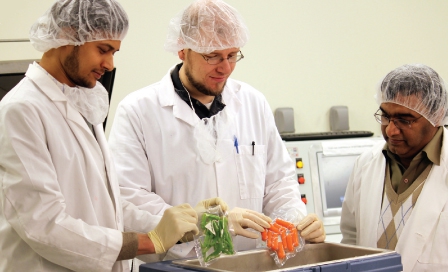Feature: Food-Safety Engineering

Recent headlines about listeria-tainted cantaloupe serve as grim reminders that food is not always as safe as it looks or tastes. Despite a host of high-tech efforts, E. coli and other food-borne illnesses kill thousands of Americans each year. Now, researchers in the emerging field of food-safety engineering are developing innovative new methods to protect what we eat, from farm to table. Call it the Food Safety Network.
You won’t see celebrity chefs whipping up lunch in these test kitchens. Still, Jaimie Oliver and other health-eating evangelists would feel right at home at facilities like Ohio State University’s High Pressure Food Processing (HPP) Lab, with its commercial-grade equipment, specialized fryers, and high-tech prep area. They’d also savor its mission: engineering recipes for ridding food of bacteria that sicken more than 1 in 6 Americans each year.
The lab, run by the departments of Food Science and Technology and Food, Agricultural, and Biological Engineering, is part of an emerging, multidisciplinary field known as food-safety engineering. Years before terrorism concerns and highly publicized outbreaks involving tainted spinach, eggs, and peanut butter spurred Congress to pass the Food Safety Modernization Act last December, engineering educators across the country were working with microbiologists, chemists, food scientists, and other faculty on innovative technologies to protect and follow foods. Their method: apply engineering principles to address microbiological and chemical food-safety challenges and develop unconventional solutions to imminent problems.
Cooking Up Protection
Humans have sought trustworthy methods of preparing and preserving food since hunter-gatherer days. The most common, time-honored means of keeping food safe is what food engineers call “thermal processing”—a.k.a. cooking. The 19th and 20th centuries brought two more-advanced thermal methods: canning and freezing. The former, invented to feed an army during the first years of the Napoleonic wars, produces some of “the safest food you can have,” says biology Prof. Robert Brackett, director of the Institute for Food Safety and Health at the Illinois Institute of Technology.
These traditional techniques all alter the appearance, taste, and texture of food, however. Most also reduce such nutrients as vitamins. Consumers began demanding “minimally processed foods [that] can retain more nutrients for health and wellness,” along with sensory qualities much closer to the fresh state, notes Ohio State’s HPP lab director V. M. Balasubramaniam, associate professor of food science and biological engineering. So industry began investigating different approaches.
Perhaps the most advanced new method is high-pressure processing (HPP). This minimalist technique kills many bacteria and some viruses by subjecting food to pressures similar to those required to make industrial diamonds, explains Ohio State’s Balasubramaniam. Unlike thermal treatment, pressure acts equally at all points of a product and thus eliminates the denaturation, browning, and film formation associated with cooking and canning. And because HPP does not cause changes in texture or taste, it is appropriate for foods easily ruined by heat, such as guacamole, raw oysters, salsa, smoothies, and a host of ready-to-eat meals.
The lab where Ohio State’s Balasubramaniam and fellow food-safety engineers are working with industry to perfect HPP resembles a mix of high-tech NASA design shop, commercial food plant, and Julia Child’s kitchen. Hoisting food samples as large as 5 liters into a pressure vessel, researchers study the effect of applying anywhere from zero to more than 100,000 pounds per square inch of pressure on both microbes and foods. A specially programmed computer allows them to control pressure, temperature, and other parameters, while specialized devices provide such information as the reaction of bacterial spores and microbes to various pressure and heat conditions. A nearby kitchen also stocks familiar tools for preparing foods to study, with other university facilities providing professional-grade devices that can peel, chop, freeze, fry, extrude, homogenize, and package foods.
As the need to safeguard food expands, so does the range of expertise demanded of engineers and educators in this exciting new specialty. A food-safety engineer must be “quite knowledgeable in engineering fundamentals and at the same time needs to answer or address how [foods] are safe microbiologically,” notes Ohio State’s Balasubramaniam. Like him, many pioneers have food, chemical, or mechanical engineering backgrounds, “but through experience now we are forming this subset called food-safety engineering.”
Preparing students for careers in food-safety engineering may require academic adjustments. Food science and food engineering typically have resided in schools of agriculture, not engineering. Moreover, most offer subfields in food engineering, food chemistry, or food technology rather than a full menu of courses. Some universities, such as IIT, offer graduate degrees or programs with “food safety engineering” in the title. However, at this point, it’s more of an area of research within the broader area of food science.
Will food-safety engineering join bioengineering as an interdisciplinary field in its own right? Carmen Moraru, a food-safety engineering professor at Cornell Univerisity, says the increasing public and industry interest in food safety ultimately “may be the common denominator” that creates a signature dish from today’s disparate academic specialty ingredients. Bon appétit!
This article by Beryl Lieff Benderly appears in longer form in the October, 2011 edition of ASEE’s Prism magazine.
Filed under: Special Features
Tags: Agricultural Engineering, Food Industry, food processing, Food safety, food-safety engineering, research labs








